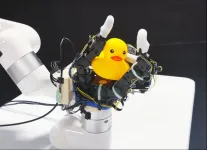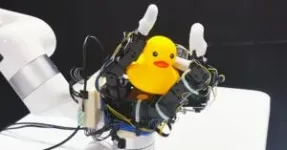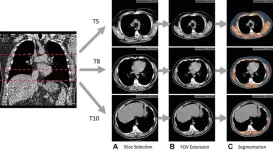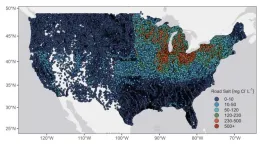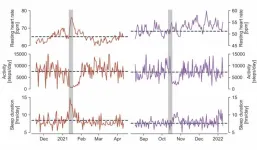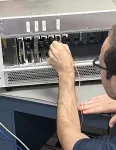(Press-News.org) Inspired by the effortless way humans handle objects without seeing them, a team led by engineers at the University of California San Diego has developed a new approach that enables a robotic hand to rotate objects solely through touch, without relying on vision.
Using their technique, the researchers built a robotic hand that can smoothly rotate a wide array of objects, from small toys, cans, and even fruits and vegetables, without bruising or squishing them. The robotic hand accomplished these tasks using only information based on touch.
The work could aid in the development of robots that can manipulate objects in the dark.
The team recently presented their work at the 2023 Robotics: Science and Systems Conference.
To build their system, the researchers attached 16 touch sensors to the palm and fingers of a four-fingered robotic hand. Each sensor costs about $12 and serves a simple function: detect whether an object is touching it or not.
What makes this approach unique is that it relies on many low-cost, low-resolution touch sensors that use simple, binary signals—touch or no touch—to perform robotic in-hand rotation. These sensors are spread over a large area of the robotic hand.
This contrasts with a variety of other approaches that rely on a few high-cost, high-resolution touch sensors affixed to a small area of the robotic hand, primarily at the fingertips.
There are several problems with these approaches, explained Xiaolong Wang, a professor of electrical and computer engineering at UC San Diego, who led the current study. First, having a small number of sensors on the robotic hand minimizes the chance that they will come in contact with the object. That limits the system’s sensing ability. Second, high-resolution touch sensors that provide information about texture are extremely difficult to simulate, not to mention extremely expensive. That makes it more challenging to use them in real-world experiments. Lastly, a lot of these approaches still rely on vision.
“Here, we use a very simple solution,” said Wang. “We show that we don’t need details about an object’s texture to do this task. We just need simple binary signals of whether the sensors have touched the object or not, and these are much easier to simulate and transfer to the real world.”
The researchers further note that having a large coverage of binary touch sensors gives the robotic hand enough information about the object’s 3D structure and orientation to successfully rotate it without vision.
They first trained their system by running simulations of a virtual robotic hand rotating a diverse set of objects, including ones with irregular shapes. The system assesses which sensors on the hand are being touched by the object at any given time point during the rotation. It also assesses the current positions of the hand’s joints, as well as their previous actions. Using this information, the system tells the robotic hand which joint needs to go where in the next time point.
The researchers then tested their system on the real-life robotic hand with objects that the system has not yet encountered. The robotic hand was able to rotate a variety of objects without stalling or losing its hold. The objects included a tomato, pepper, a can of peanut butter and a toy rubber duck, which was the most challenging object due to its shape. Objects with more complex shapes took longer to rotate. The robotic hand could also rotate objects around different axes.
Wang and his team are now working on extending their approach to more complex manipulation tasks. They are currently developing techniques to enable robotic hands to catch, throw and juggle, for example.
“In-hand manipulation is a very common skill that we humans have, but it is very complex for robots to master,” said Wang. “If we can give robots this skill, that will open the door to the kinds of tasks they can perform.”
Paper title: “Rotating without Seeing: Towards In-hand Dexterity through Touch.” Co-authors include Binghao Huang*, Yuzhe Qin, UC San Diego; and Zhao-Heng Yin* and Qifeng Chen, HKUST.
*These authors contributed equally to this work.
END
Robotic hand rotates objects using touch, not vision
2023-07-25
ELSE PRESS RELEASES FROM THIS DATE:
AI as a leader? A conversation we need to have!
2023-07-25
How can an AI become the boss? Already during the COVID-19 pandemic, we have seen how crucial digital technologies have become for leadership. Without Microsoft Teams, Zoom, and related programs, leaders would not have been able to reach their employees easily. These tools continue to enjoy a secured place in the office today.
There is no surprise there. Anything that can be considered a competitive advantage will be utilized as such, and digital options are often quicker, more cost-efficient, or simply more convenient. Indeed, in the future, leadership as a whole is going to make giant leaps toward digitalization. The next phase is therefore only logical: digitally supported leadership, that ...
Mount Sinai receives significant funding to study which coronary revascularization procedure best improves survival and quality of life for women and underserved minority groups
2023-07-25
The Icahn School of Medicine at Mount Sinai will help lead and launch the first clinical trial focusing on women and minority populations to determine which coronary revascularization procedure best improves their survival and quality of life. This trial will be funded through $29.9 million from the Patient-Centered Outcomes Research Institute Award to the Icahn School of Medicine at Mount Sinai and Weill Cornell Medicine.
“While there have been many trials comparing coronary artery bypass graft (CABG) surgery and percutaneous coronary intervention (PCI), most have enrolled ...
Large PCORI award funds study of surgical options for coronary artery disease in underrepresented patient populations
2023-07-25
A multi-institutional team of scientists led by Dr. Mario Gaudino, the Stephen and Suzanne Weiss Professor in Cardiothoracic Surgery and assistant dean for clinical trials at Weill Cornell Medicine, has been approved for a nearly $30 million funding award from the Patient-Centered Outcomes Research Institute (PCORI). The award will fund the first study among women and Black and Hispanic patients comparing the effectiveness of two revascularization options used to treat coronary artery disease.
Coronary artery disease, a narrowing or blockage of coronary arteries due to plaque buildup, is the leading ...
Offsetting or reducing CO2: This is what consumers want
2023-07-25
Whether it’s recycled aluminum at Apple’s MacBook Air or compensation payments from Microsoft for emissions over the life of an Xbox, climate-friendly products are becoming more and more popular. But do consumers also pay attention to how a neutral climate balance is created? Companies use two ways to accomplish this goal: reducing emissions directly or compensating them afterward. “Both approaches can make a product climate-neutral and have a positive impact on the environment, while compensatory measures are being discussed more and more critically in the public. To this end, the consumers in our study were ...
AI uses lung CT data to predict mortality risk
2023-07-25
OAK BROOK, Ill. – Artificial intelligence (AI) can use data from low-dose CT scans of the lungs to improve risk prediction for death from lung cancer, cardiovascular disease and other causes, according to a study published in Radiology, a journal of the Radiological Society of North America (RSNA).
The U.S Preventive Services Task Force recommends annual lung screening with low-dose CT (LDCT) of the chest for individuals ages 50 to 80 years with a high risk of lung cancer, such as longtime ...
Road salt pollution in many US lakes could stabilize at or below thresholds set by the EPA
2023-07-25
Since de-icing with road salt began in the 1930s, the salinity of lakes across much of the US has been steadily increasing, posing a potential threat to aquatic life and drinking water supplies. However, a cautiously optimistic new study in Limnology and Oceanography Letters concludes that if we can hold steady or decrease road salt use, levels in many lakes could stabilize below thresholds set by the US Environmental Protection Agency (EPA).
“For the majority of US lakes, road salt pollution could be a solvable problem, if ...
Data from wearable devices shows power of vaccines against SARS-CoV-2
2023-07-25
Data harvested from wearable devices and health apps could be valuable in public health research, according to a study. Vaccines can prevent SARS-CoV-2 infections and, in cases where the virus is able to break through, vaccination lowers the risks of severe disease, hospitalization, ICU admission, and death. Marc Wiedermann and colleagues used data from smartwatches and fitness trackers collected by the Corona Data Donation Project to investigate whether vaccination produces measurable changes in personal health and wellbeing. The Corona-Datenspende-App was launched ...
Spraying just 12% of the room kills 85% of the mosquitoes
2023-07-25
A study in a semi-natural setting finds that targeting just the very bottom of a room’s walls with insecticide will kill most of the mosquitoes, suggesting a cheaper and easier way to treat houses during disease outbreaks. The mosquito Aedes aegypti is a vector for serious diseases, including dengue, chikungunya and Zika. In Asia and Latin America, one approach taken to control mosquitoes that rest inside homes is indoor residual spraying, in which interior walls are coated with a persistent insecticide. However, the large surface area that must be coated makes the approach expensive to implement. Luca Facchinelli and colleagues sought to identify ...
Deep Longevity and House of Gaia announce strategic partnership to advance longevity research and wellness solutions
2023-07-25
Deep Longevity is at the forefront of AI-based longevity science, using deep learning techniques to analyse multiple data types and develop accurate aging clocks. These clocks provide valuable insights into an individual's biological age, offering a holistic understanding of their health and longevity potential. By partnering with House of Gaia, Deep Longevity seeks to bring their cutting- edge technologies and expertise to a wider audience, empowering individuals to take control of their well-being.
House of Gaia is a respected name in the wellness industry, known for its comprehensive range of holistic health services and programs. By ...
SwRI developing advanced electronic warfare system for U.S. Air Force
2023-07-25
SAN ANTONIO — July 25, 2023 —The U.S. Air Force awarded Southwest Research Institute a $4.8 million contract to further develop an adaptable, “continuously staring,” next-generation electronic warfare system capable of detecting advanced enemy radar signals. Using cutting-edge algorithms in a congested signal test environment, the system demonstrated more than 99% probability of intercepting signals with no false detections in a USAF verified simulated environment, a software model loaded with enemy radar.
“Eliminating ...
